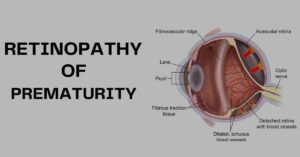If you or any of your family members, particularly those 50 and above, feeling any discomfort in daily activities. Such as reading, driving, and recognizing faces. There is a possibility that it is a symptom of age-related macular degeneration.
In this article we have discussed in detail about ARMD.
Table of Contents
ToggleWhat is Age-Related Macular Degeneration?
Age-related macular degeneration (AMD) is a degenerative eye disease that affects the macula. It is the part of the retina responsible for central vision. It is a leading cause of blindness in older adults.
What are the types of Age-Related Macular Degeneration?
There are two types of AMD:
- Dry AMD
- Wet AMD
Dry AMD
It is the most common form of the disease and is characterized by the gradual thinning of the macula. This can lead to the formation of small, yellowish deposits called drusen.
Dry AMD typically progresses slowly and can cause a gradual loss of central vision over time.
Wet AMD
It is characterized by the growth of abnormal blood vessels under the macula that can leak fluid and cause damage.
Wet AMD, also known as Neovascular AMD. It is a more severe form of the disease. It is caused by the growth of abnormal blood vessels under the macula.
These blood vessels can leak fluid and blood, causing damage to the macula and rapid loss of central vision.
What Are The Stages Of Age-Related Macular Degeneration?
AMD can also be classified by stages:
Early AMD
It is characterized by the presence of small drusen and little or no vision loss.
Intermediate AMD
It is characterized by the presence of medium-sized drusen and some vision loss.
Late AMD
It is characterized by advanced vision loss, either due to the severe thinning of the macula in dry AMD or the growth of abnormal blood vessels in wet AMD.
It’s important to note that AMD can progress differently in different individuals and that the stages may not be linear.
Some people may progress from early to late AMD in a short period of time, while others may have intermediate or late AMD for many years with little or no progression.
How is Age-Related Macular Degeneration Inherited?
While the exact causes of AMD are not fully understood, research has identified certain genetic variations that are associated with an increased risk of developing the disease.
There are several genes that have been linked to an increased risk of AMD, including:
- Complement Factor H (CFH)
- Age-Related Maculopathy Susceptibility 2 (ARMS2)
- High-Temperature Requirement Factor A1 (HTRA1)
These genes regulate the complement system. It is a part of the immune system that helps clear debris and abnormal cells from the body.
Variations in these genes can lead to an overactive complement system, which can contribute to the development of AMD.
It’s also worth noting that having a family history of AMD increases the risk of developing the disease.
However, just because someone has a family history of AMD, it doesn’t mean they will develop the disease.
Overall, while genetics play a role in AMD, most people with AMD don’t have a family history of the disease and it’s not considered to be inherited in a straightforward manner.
It’s a multifactorial disease with both genetic and environmental factors playing a role.
What Are The Symptoms of Age-Related Macular Degeneration?
Symptoms of AMD include blurriness or distortion of central vision and difficulty with activities such as reading and driving.
The symptoms of Age-Related Macular Degeneration (AMD) can vary depending on the type and stage of the disease.
However, some common symptoms of AMD include:
- Blurred or distorted central vision: This can make it difficult to read, drive, or recognize faces.
- Difficulty with tasks that require fine detail: This can include difficulty with activities such as threading a needle, or seeing small print.
- A gradual loss of central vision: This can happen over time, making it more difficult to see fine details or to see in low light conditions.
- A dark or empty area in the center of vision: This can happen in the advanced stages of AMD.
Symptoms of Wet AMD can occur suddenly and can be more severe than dry AMD.
Some symptoms of Wet AMD include:
- A sudden decrease in vision
- Straight lines appearing wavy
- A dark spot or blurry area in the center of the vision
- Loss of color vision
It’s important to note that the early stages of AMD may not have symptoms. So regular eye exams are recommended for people who are at risk of the disease.
If you notice any changes in your vision, it’s important to schedule an appointment with an eye care professional as soon as possible. As early diagnosis and treatment can help to slow or halt the progression of the disease.
What Gene Causes Age-Related Macular Degeneration?
Age-Related Macular Degeneration (AMD) is a complex disease that is thought to be caused by a combination of genetic and environmental factors.
Several genes have been linked to an increased risk of developing AMD, but none of them alone are considered to cause the disease.
Some of the most well-studied genes that are associated with an increased risk of AMD include:
- Complement Factor H (CFH)
- Age-Related Maculopathy Susceptibility 2 (ARMS2)
- High-Temperature Requirement Factor A1 (HTRA1)
CFH gene is involved in the regulation of the complement system and variations in this gene have been associated with an increased risk of developing AMD, particularly the dry form of the disease.
ARMS2 gene is also associated with the complement system and variations in this gene have been linked to an increased risk of developing the wet form of AMD.
HTRA1 gene is associated with the regulation of the protease enzyme and variations in this gene have been linked to an increased risk of developing AMD.
It’s important to note that genetic testing for these variants is only available for research purposes. It is not for clinical diagnosis and treatment.
What Are The Causes of Age-Related Macular Degeneration?
The exact causes of Age-Related Macular Degeneration (AMD) are not fully understood. Genetics and the environment may be involved in its development.
Some of the main risk factors for AMD include:
Age
The risk of developing AMD increases as people get older.
Genetics
Some studies have suggested that smoking, high blood pressure, high cholesterol, obesity, poor diet, and sun exposure may increase the risk of developing AMD.
Race
AMD is more common in white people compared to other racial groups.
Gender
AMD is more common in women than in men.
It’s worth noting that many people with risk factors for AMD will not develop the disease, and many people without known risk factors will develop the disease.
Research also suggests that there are other factors that may play a role in the development of AMD such as:
- Oxidative stress
- Inflammation
- Accumulation of waste products in the retina
These factors are thought to contribute to damage to the cells in the macula and the formation of abnormal blood vessels in the wet form of AMD.
Overall, the causes of AMD are complex and multifactorial, and more research is needed to fully understand the underlying mechanisms involved in the disease.
How is Age-Related Macular Degeneration Diagnosed?
Age-Related Macular Degeneration (AMD) is typically diagnosed during a comprehensive eye exam, which can include the following tests:
Visual Acuity Test
This test measures how well you can see letters or symbols from a distance. It can help to identify any vision loss caused by AMD.
Dilated Eye Exam
This test involves dilating the pupils with eye drops. It allows the eye care professional to see the back of the eye, including the retina and the macula.
This can help to identify any abnormalities or damage caused by AMD.
Amsler Grid Test
This test involves looking at a grid of straight lines while covering one eye. It can help to identify any distortion or waviness in the lines caused by AMD.
Optical Coherence Tomography (OCT)
This test uses light waves to create a detailed image of the retina. It helps to identify any thickening or thinning of the macula caused by AMD.
Fluorescein Angiography (FA)
This test involves injecting a dye into the bloodstream and taking photographs of the retina. It can help to identify any abnormal blood vessels caused by wet AMD.
If AMD is suspected, an ophthalmologist or a medical doctor specializing in eye care will be able to diagnose the disease. It can determine the stage of the disease, which will help to guide treatment decisions.
It’s important to note that the early stages of AMD may not have symptoms. So regular eye exams are recommended for people who are at risk of the disease.
What Is The Treatment Options Available For Age-Related Macular Degeneration?
The treatment options for Age-Related Macular Degeneration (AMD) depend on the type and stage of the disease.
For Dry AMD
- There is no cure for Dry AMD, but there are some treatments that can help to slow the progression of the disease and preserve vision.
- One treatment option is the use of high-dose antioxidant vitamin and mineral supplements.
- Low vision aids such as magnifying glasses, brighter lighting, and special computer programs can also help people with dry AMD to maintain their independence and quality of life.
For Wet AMD:
- Wet AMD is considered a more severe form of the disease and can cause rapid vision loss if left untreated.
- Treatment options for wet AMD include:
Anti-angiogenic therapy
This involves injecting drugs into the eye. It can help to slow the growth of abnormal blood vessels and reduce fluid leakage, which can help to preserve vision.
These drugs include ranibizumab (Lucentis), aflibercept (Eylea), and brolucizumab (Beovu)
Photodynamic therapy (PDT)
This treatment involves injecting a drug into the bloodstream that is activated by a special light.
This can help to destroy abnormal blood vessels and reduce fluid leakage.
Laser therapy
This treatment can seal off abnormal blood vessels and reduce fluid leakage. Although it’s not as common as the above-mentioned therapies.
It’s important to note that early diagnosis and treatment can help to slow or halt the progression of the disease.
So it’s important to schedule regular eye exams and seek medical attention if you notice any changes in your vision.
It’s also worth noting that there is ongoing research for new treatment options, such as stem cells and gene therapy, which may become available in the future.
Conclusion
Age-related macular degeneration is a common eye condition that affects people over the age of 50. It is the leading cause of vision loss in older adults.
Treatment options include lifestyle changes, vitamin supplements, and in some cases, surgery. Like other hereditary eye diseases, early diagnosis and treatment can help to slow the progression of this disease.
Regular eye exams are recommended for people who are at risk of the disease.





